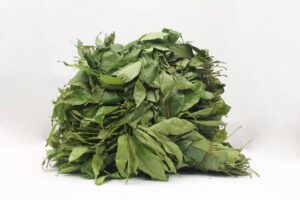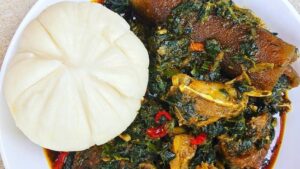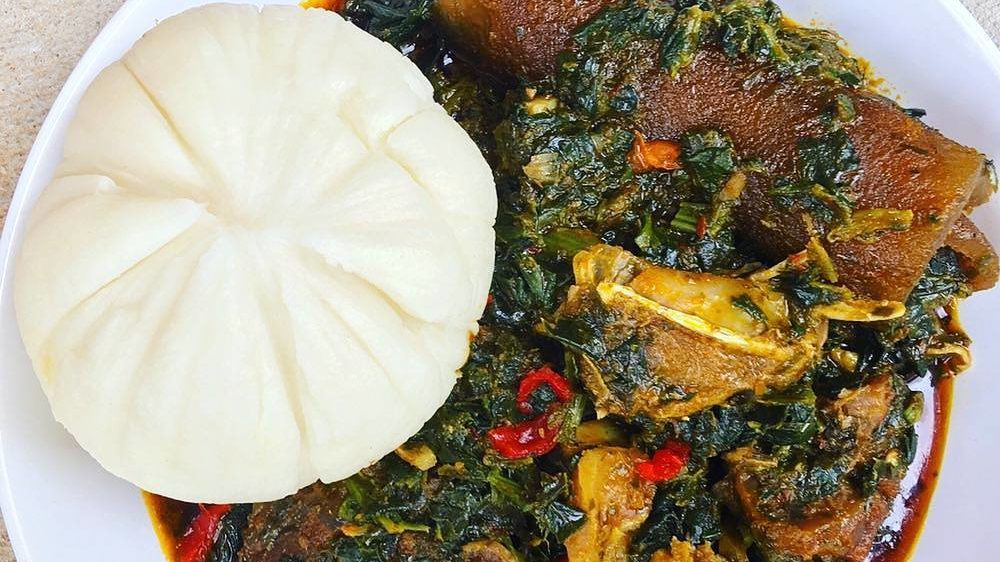Subtotal ₦0.00
Nigeria’s diverse cultures offer a vibrant tapestry of culinary experiences, and among the most celebrated is Afang Soup — a rich, leafy delicacy that originates from the Efik and Ibibio people of Cross River and Akwa Ibom States in southern Nigeria. Also popular among the broader Niger Delta region, Afang Soup has transcended its local roots to become a national favorite.
In this blog post, we explore the origins, ingredients, nutritional value, and the step-by-step Calabar-style recipe of Afang Soup — a dish that blends simplicity, tradition, and bold flavors into a truly satisfying meal.
Afang Soup is more than just food — it’s an expression of heritage.
The Origin of Afang Soup
Afang Soup is deeply rooted in the culinary traditions of the Efik and Ibibio tribes. These coastal communities are known for their resourcefulness, especially with seafood and local vegetables. While the name “Afang” refers to the local leaf used in the soup, the dish itself represents community, celebration, and nourishment.
Though similar to Edikang Ikong in terms of leafy base, Afang Soup is distinct in flavor and texture. It’s also more budget-friendly and often cooked during family gatherings, weddings, and festivals.


What Makes Afang Soup Unique?
The defining ingredients of Afang Soup are:
- Afang leaves (Gnetum africanum), locally called Okazi in Igbo.
- Waterleaf (Talinum triangulare).
- A generous assortment of meat, fish, and periwinkles.
- Palm oil and native spices that enhance the taste.
Afang leaves are slightly tough and require longer cooking or pounding to release their flavor and soften their texture. This is often balanced with the softness and water content of waterleaf, resulting in a hearty, nutrient-rich soup.
Nutritional Value of Afang Soup
Afang Soup isn’t just delicious — it’s a nutritional powerhouse. Here’s a breakdown:
- Afang (Okazi) leaves are rich in fiber, protein, and antioxidants. They aid digestion and boost the immune system.
- Waterleaf is packed with vitamins A and C, calcium, and iron.
- Palm oil provides healthy fats and vitamin E.
- Periwinkles and assorted meats are excellent protein sources.
It’s a meal that supports heart health, bone strength, and energy — making it ideal for people of all ages.
Ingredients for Calabar-Style Afang Soup
Before cooking Afang Soup, it’s essential to gather all ingredients. The quantity can be adjusted depending on the number of servings.
Core Ingredients (for 6–8 servings)
- Afang leaves (Okazi) – 3 cups (sliced or blended)
- Waterleaf – 5 cups (washed and sliced)
- Palm oil – 1½ cups
- Beef – 500g
- Goat meat (optional) – 300g
- Smoked fish – 2 medium-sized
- Stockfish – 200g
- Periwinkles (in shell or shelled) – 2 cups
- Crayfish (blended) – 3 tablespoons
- Seasoning cubes – 3 to 4
- Salt – to taste
- Pepper – to taste (preferably Scotch bonnet or dry chili)
- Snails (optional) – 1 cup, cleaned
- Ponmo (cow skin, optional) – 1 cup, diced
Preparation Steps
Step 1: Prepare the Leaves
🥬 Afang Leaves:
- If using fresh Afang leaves, wash thoroughly and pound in a mortar or blend coarsely. You can buy already-ground Okazi leaves from the market to save time.
- Afang leaves are tough, so blending or pounding helps soften them.
Waterleaf:
- Wash and slice finely. You can use spinach or lamb’s lettuce as a substitute if waterleaf is unavailable.
Step 2: Prepare the Proteins
- Wash and season your meat, goat meat, and ponmo with salt, seasoning cubes, and pepper. Boil until tender.
- In a separate pot, boil stockfish and snails (if using) until soft.
- Soak smoked fish in hot water, clean out the bones, and set aside.
- Wash periwinkles thoroughly with salt to remove sand. You can use shelled or unshelled periwinkles depending on your preference.
Step 3: Combine and Build Flavor
- Combine all meats and fish in one large pot, including the meat stock. Add more water if necessary.
- Add palm oil and allow to boil for 5 minutes.
- Introduce crayfish, pepper, and extra seasoning cubes. Stir and simmer.
- Add the periwinkles and smoked fish.
- Gently stir in the sliced waterleaf. Cover and allow to cook for 5–7 minutes. Waterleaf will release moisture, so avoid adding too much water at the beginning.
- Add the pounded/blended Afang leaves. Stir thoroughly to mix.
- Let the soup cook for another 7–10 minutes on medium heat. Stir occasionally to prevent burning.
- Taste and adjust salt and seasoning as needed.
Step 4: Final Touch
Afang Soup should be thick and richly coated in palm oil, with the flavor of the leaves and protein harmoniously blended. If it appears too watery, cook uncovered for a few more minutes to thicken.
Once satisfied with the texture and taste, take the soup off the heat and let it rest for a few minutes before serving.
Serving Suggestions
Afang Soup is traditionally served hot with a starchy side, including:
- Fufu (Cassava Dough)
- Garri (Eba)
- Pounded Yam
- Semovita
- Wheat meal
- Amala
It can also be eaten on its own as a rich stew with rice or boiled plantains.
Storage and Reheating
- Refrigeration: Afang Soup can be stored in an airtight container for 3–5 days.
- Freezing: It freezes well and can last up to 2–3 months without losing flavor.
- Reheating: Warm gently on the stove over low heat. Add a little water if it’s too thick.
Tips and Tricks
- Palm Oil: Don’t skimp on the oil — it’s vital for taste and texture.
- Afang Ratio: Too much Afang can make the soup tough; balance is key.
- Protein Variations: Feel free to customize with turkey, chicken, or seafood depending on dietary needs.
- Vegetarian Option: Skip the meats and use mushrooms or tofu, along with vegetable broth for a plant-based version.
Why Calabar Afang Soup Is a Must-Try
This soup tells a story — one of tradition, richness, and the culinary genius of southern Nigeria. Whether you’re a Nigerian looking to reconnect with your roots or an adventurous food lover, Afang Soup is a recipe worth trying.
Its taste lingers, not just on the tongue but in memory. It’s the kind of dish that reminds you of family warmth, community, and cultural pride.












